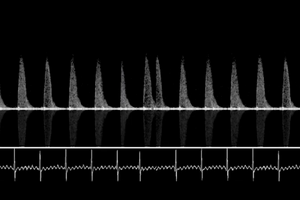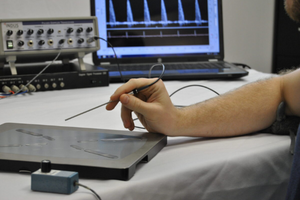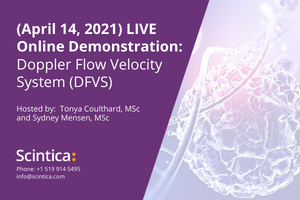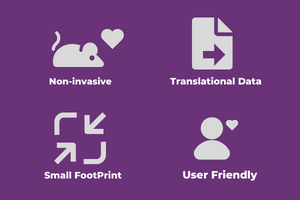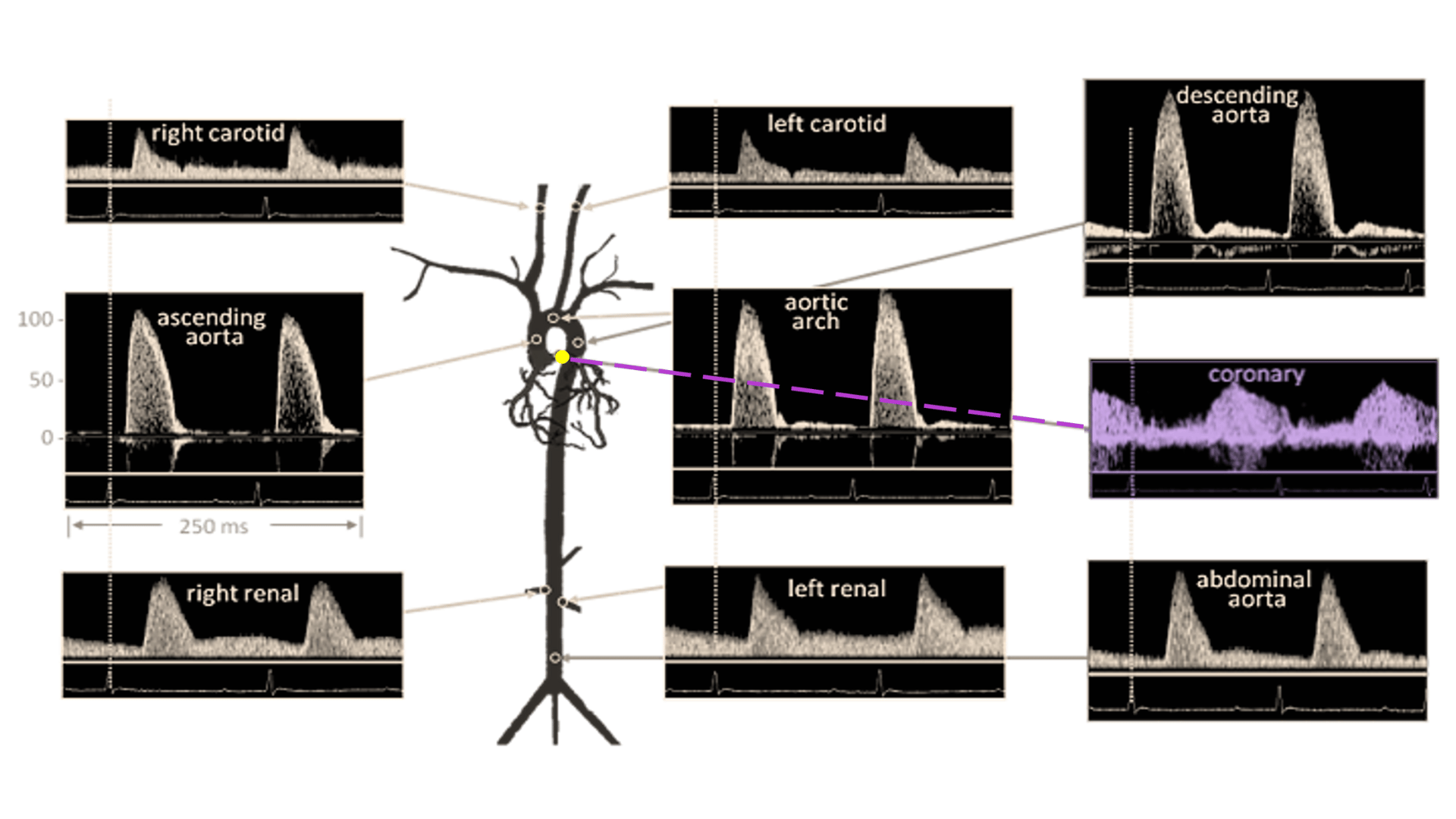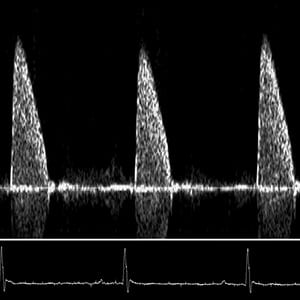Doppler Flow
Velocity System
A Non-invasive Measure of Cardiovascular Physiology and Function
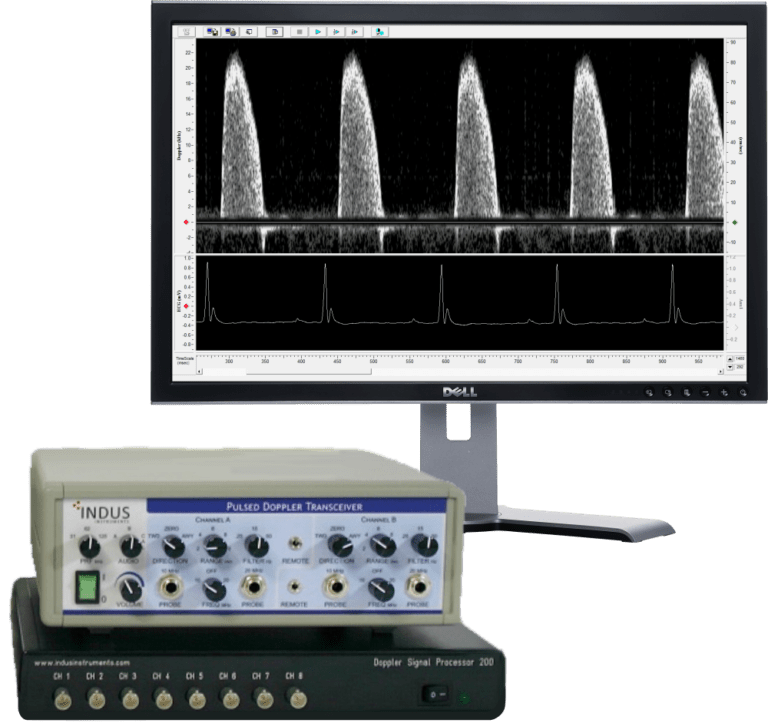
System Overview
The Indus Doppler Flow Velocity System is a high-frequency, real-time pulsed Doppler measurement device with integrated data analysis software designed for measuring cardiovascular function in small animals. The high sampling rates grant excellent temporal resolution, making this the ideal system for studying fast heart rates and rapid blood accelerations present in small animals. Hardware components include the Pulsed Doppler Transceiver (PDT – a 10 & 20 MHz switchable dual channel system), Doppler Signal Digitizer (DSD), Doppler Workstation (DW), and handheld miniature probe(s).
Pulsed Doppler signals from the PDT are digitized at high sampling rates by the DSD and the workstation software. The acquired signals are processed using a fast Fourier transform algorithm and displayed as real-time grayscale Doppler flow velocity spectrograms. The workstation software permits recording and analysis of these spectrograms, ideal for report generation and publication purposes. This system has been successfully used in publications with mice, rats, bats, naked mole rats and other small animals. It is also capable of measuring blood flow velocities in larger animals using our implanted extra-vascular Doppler cuff probes.
Non-Invasive
Using a miniature handheld probe, flow velocities and differentials in various arteries, including the aorta, are reliably measured by placing the tip of the probe at a sharp angle relative to the direction of flow to be measured
Small Footprint
A powerful system that is both compact and easily transportable, allowing it to be scaled in larger facilities with ease or shared between cooperating labs without complication
Translational Data
Large bodies of literature support the translational relevance of rodent flow velocity data to clinical findings: study areas include cardiac function, myocardial perfusion, pressure overload, arterial stiffness, and more
Applications
Cardiac Function:
Systolic and Diastolic
Area
- Myocardial Infarction
- Heart Failure
- Hypertrophy
- Cardiomyopathy
Flow Parameter
- Aortic Outflow Velocity
- Mitral Inflow Velocity
Coronary
Flow Reserve
Area
- Myocardial Ischemia
- Pressure Overload-Hypertrophy
- Artherosclerosis
Flow Parameter
- Hyperemic/Baseline Coronary Flow Velocity Ratio
Arterial Stiffness
(Pulse Wave Velocity)
Area
- Hypertension
- Artherosclerosis
Flow Parameter
- Aortic Arch Velocity
- Abdominal Aortic Velocity
Pressure-Overload
(Stenosis)
Area
- TAC Banding Model
Flow Parameter
- Carotid (R/L) peak velocity ratio
- Stenotic jet velocity-estimation of pressure gradient across stenosis
Peripheral Artery
Disease and Perfusion
Area
- Renal, Carotid, Iliac, Femoral and Saphenous Vein Flow Velocities
Flow Parameter
- Flow Velocities in peripheral vessels before & after a surgical intervention or during therapeutic response
Transducers
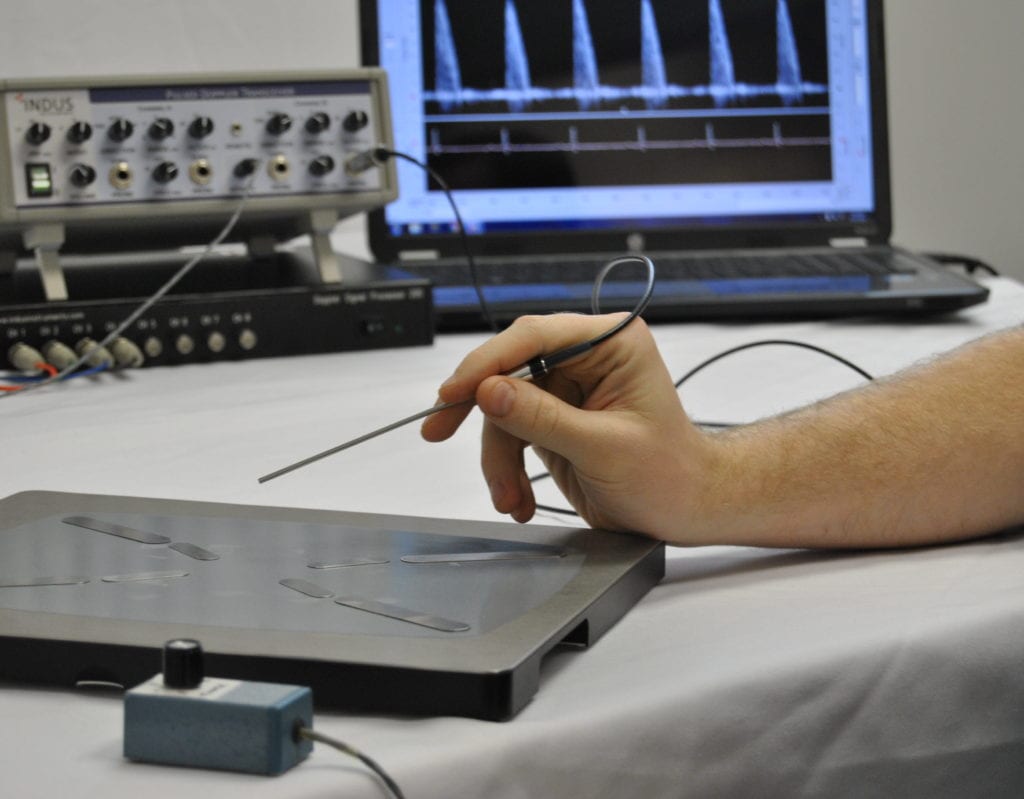
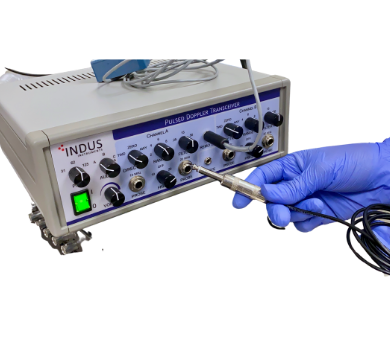
Hand-Held Transducer
For most applications, a noninvasive rigid probe with an end-mounted transducer is required. The active element is a 1.0 mm diameter (10 or 20 MHz) piezoelectric crystal recess-mounted at the end of the probe using epoxy molded into a lens to focus the sound beam.
This type of focused probe has been applied in mice and rats to measure cardiac and arterial blood velocity non-invasively. The probe can be held with a steady hand, or mounted in a micromanipulator which often assists with measurement accuracy and consistency.
Transducer
For chronic (implanted), extra-vascular applications or when the vessel cannot be accessed by a probe, a cuff transducer can be used. The cuff body is molded of flexible silicone and split lengthwise so that it can be slipped around the vessel. The piezoelectric crystal (10 or 20 MHz) is 1.0 mm diameter and mounted at a 45-degree angle using medical-grade epoxy.
Parameters
Surgical Monitoring
& Vital Sign Measurements
- Heart Rate
- R-R Interval
Peripheral Artery:
Carotid, Renal,
Femoral & Tail
- Peak Velocity
- Mean & Minimum flow velocity
- Pulsatility Index
- Resistivity Index
Diastolic: Mitral
Inflow Velocity
- E-peak & E-stroke velocity
- E-time duration
- E-acceleration & E-deceleration time
- E-peak to ½ E-peak time
- E-linear deceleration time & rate
- A-stroke distance
- A-time duration
- E-A peak velocity ratio
- Isovolumic contraction time
- Isovolumic relaxation time
Other: Coronary, Transverse &
Abdominal Aorta
- Peak Diastolic Velocity (Coronary)
- Peak Systolic Velocity (Coronary)
- Diastolic & Systolic Area (Coronary)
- Ratios PSV/PDV & SA/DA
- Pulse Wave Velocity
Hardware
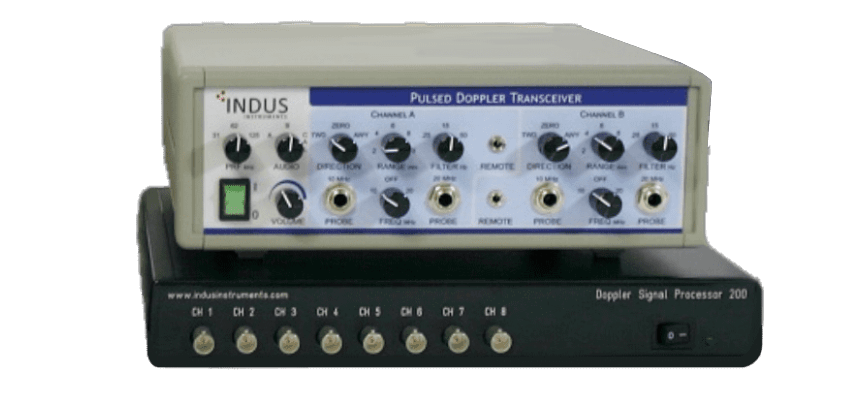
Doppler Signal Digitizer
-
Channels - Channels 1 and 2 = Doppler InPhase & Quadrature
Channel 3 = ECG Channels 4 – 8 = Auxiliary inputs -
Input Range - ±10 V
-
Coupling - AC or DC software selectable
-
Sampling - 125 kHz per channel, 16 bits
-
Low Pass Filter - 10, 20, 30, 40, 50, 60, 70, 80, 90, 100, 110, 120, 130, 140 or 150 kHz (via Hardware)
-
Low Pass Filter - 10, 20, 30, 40, 50, 60, 70, 80, 90, 100, 110, 120, 130, 140 or 150 kHz (via Hardware)
-
High Pass Filter - 100, 200, 400, 600, 800, 1000, 1500 or 2000 Hz (Second or Fourth order, via Software)
-
Digital Signal Processor - 500MHz Dual Core Processor
-
Data Link to PC - USB 2.0 (480 Mb/s)
-
Power - 100-240 VAC Universal Adapter
Pulsed Doppler Transciever
-
Channels - Two, each switchable between 10MHz & 20MHz
-
Power - 110 VAC / 60Hz OR 220 VAC / 50Hz
-
Recorder Outputs - 2 from each channel (Phasic & Mean)
-
Audio Outputs - 2 from each channel (InPhase & Quadrature)
-
Audio Monitor - Amplifier & speaker selectable from any channel
-
External Ground - Intended for chasis grounding, if required
-
USB, RF/DEMOD - Future use
-
Transmitter Pulse Width - 0.4 μs
-
Receiver Pulse Width - 0.32 μs
-
Variable Range Gate - 1-10 mm (1-13 μs)
-
Velocity Outputs - 0.25 V/kHz simultaneous Phasic & Mean
-
Phasic Output Filter - Phasic (1 pole at 50 Hz), Damped (1 pole at 15 Hz) and Mean (2 poles at 0.25 Hz)
-
Probe Connection - Floating & differential (single-ended, differential)
-
Velocity Range - 1-100 cm/s at 0° angle, 2-200 cm/s at 60° angle
-
Electrical Zero - Front panel switches
-
Controls - Range adjustment, Polarity Switch, Filter
-
Ultrasound Frequency - 10MHz // 20MHz
-
Pulse Repetition Frequency - 31.25, 62.5, 125 KHz // 62.5, 125 KHz
-
Transmitter Output - 25 Vpp into 50 Ohm // 35 Vpp into 50 Ohm
-
Audio Bandwidth - ≈ 100 Hz to 15 KHz // ≈ 200 Hz to 25 KHz
Imaging Gallery - Doppler Flow Velocity System
Pulse Wave Velocity
Coronary Flow
Transverse Aortic Constriction
Get access to our video presentations
Due to the sensitive nature of the content, registration is required to get access to these resources. (Immediate Access)
Publications & Articles
Application Note: Measuring Coronary Flow Reserve
System Used: Doppler Flow Velocity System M-Series View Paper Here Background Coronary flow
Science Corner: Doppler Flow Velocity Imaging at Dr. Olgin’s Research Lab
Doppler Flow Velocity Imaging at Dr. Olgin’s Research Lab Dr. Jeff Olgin. “Dr.
Article review: “Effects of Isoflurane on Coronary Blood Flow Velocity in Young, Old, and ApoE−/− Mice Measured by Doppler Ultrasound”
Article review: “Effects of Isoflurane on Coronary Blood Flow Velocity in Young, Old,
